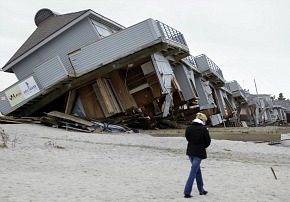Superstorm Sandy wreaked havoc on parts of the U.S. East Coast in late October after tearing through the Caribbean. In the weeks since, the storm’s scope has come into sharper focus.
Deaths
Sandy killed at least 125 people in the United States. That includes 60 in New York — 48 of them in New York City — 34 in New Jersey and 16 in Pennsylvania. At least seven people died in West Virginia, where the storm dropped heavy snow. Sandy killed 71 people in the Caribbean, including 54 in Haiti.
Losses
It’s the second-costliest storm in U.S. history after 2005’s Hurricane Katrina, which caused $128 billion in damage in inflation-adjusted dollars. Sandy caused at least $315 million in damage in the Caribbean.
Damage
Sandy damaged or destroyed homes and businesses, more than 72,000 in New Jersey alone, Gov. Chris Christie said last week. In Cuba, the number of damaged homes has been estimated at 130,000 to 200,000.
Disaster Aid
New York is seeking $42 billion in federal aid, including about $9 billion for projects to head off damage in future storms. New Jersey is seeking nearly $37 billion in aid, including $7.4 billion for future projects. New York Mayor Michael Bloomberg met with congressional leaders last week to encourage quick action on storm aid.
Magnitude
The National Hurricane Center now says tropical force winds extended 820 miles at their widest, down from an earlier estimate of 1,000 miles. Sandy’s pure kinetic energy for storm surge and wave “destruction potential” reached a 5.8 on the National Oceanic and Atmospheric Administration’s 0 to 6 scale, the highest measured.
Down the Road
Governments are seeking money to help head off future disasters, as climate scientists continue to predict rising sea levels and the potential for more bad storms. In New York, Gov. Andrew Cuomo wants electrical transformers in commercial buildings hauled to upper floors; the ability to shutter key tunnels, airports and subways; and to require hospitals to have backup power on high ground instead of on lower floors or in basements.
Was this article valuable?
Here are more articles you may enjoy.


 CEOs on Guard as Trump Rattles Companies With Series of Edicts
CEOs on Guard as Trump Rattles Companies With Series of Edicts  Alliant Latest to Sue Howden US Over Alleged ‘Smash-and-Grab’ Poaching
Alliant Latest to Sue Howden US Over Alleged ‘Smash-and-Grab’ Poaching  Expense Ratio Analysis: AI, Remote Work Drive Better P/C Insurer Results
Expense Ratio Analysis: AI, Remote Work Drive Better P/C Insurer Results  Florida Lawmakers Ready for Another Shot at Litigation Funding Limits
Florida Lawmakers Ready for Another Shot at Litigation Funding Limits 

